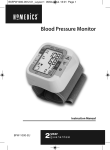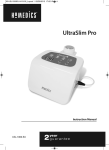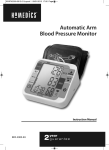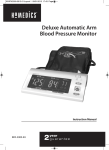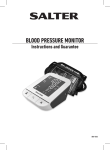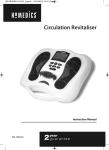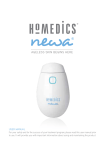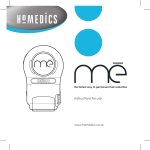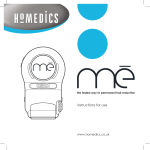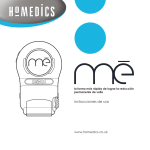Download HoMedics BPW-1000-EU blood pressure unit
Transcript
IB-BPW1000-0912-01_Layout 1 09/01/2013 13:01 Page 1 Blood Pressure Monitor Instruction Manual GB BPW-1000-EU IB-BPW1000-0912-01_Layout 1 09/01/2013 13:01 Page 2 HoMEdics Blood PrEssUrE Monitor Before use GB Before the blood pressure monitor is taken into use a number of basic steps should be observed. Please read this manual thoroughly before the blood pressure monitor is used for the first time and keep the manual for future use. the blood pressure monitor is intended for home use only. Any measurement is solely for your information and can under no circumstances replace a visit to the doctor. the blood pressure measurements should always be assessed by a qualified person (a doctor, nurse or similar) who is familiar with the user’s general medical condition. By regular use and by keeping a record of the results, this person can be kept well informed about developments in the user’s blood pressure. Measurements must never be interpreted by the user with the aim of changing levels in the use of medicine as prescribed by a doctor, but the doctor’s instructions must be followed At All tiMEs. Use of appropriate cuff size is crucial to correct measurement. Follow the instructions presented in this manual and printed on the cuff to ensure that the correct cuff size is used. the blood pressure monitor is not suited for users who suffer from arrhythmia (heart rhythm disturbances) and errors may occur in the measurement results if the user has suffered a stroke, suffers from cardiovascular diseases, has a very low blood pressure, or suffers from other symptoms such as circulatory diseases (diabetes, kidney diseases, arterial sclerosis (deposits in the arteries), or poor peripheral blood circulation (e.g. in hands and feet). Electromagnetic disturbances: the device contains sensitive electronic components. Keep it clear of strong electric or electromagnetic fields in the immediate surroundings (e.g. mobile telephones, microwave ovens) as these may temporarily reduce measurement accuracy. Use the blood pressure monitor only for its original purpose. the device is intended for measurement of blood pressure and pulse with adult persons. do not apply the monitor to infants nor to persons who cannot express their permission. the device must not be operated by children. the blood pressure monitor functions in accordance with the oscillometric measurement principle. these blood pressure changes are measured in the cuff on the basis of the arm pulse and are converted into a numerical value of the current blood pressure. simultaneously, the number of pulse beats are registered and calculated as number of pulse beats per minute. there are two kinds of discernible blood pressures. Both are expressed in mmHg (millimetres on the mercury column): the systolic and the diastolic. the systolic (‘the high blood pressure’) states the pressure when the heart chambers contract to send blood through your body, and the diastolic (‘the low blood pressure’) states the pressure when the heart is at ease and filling with blood before the next muscle contraction. the 2 IB-BPW1000-0912-01_Layout 1 09/01/2013 13:01 Page 3 connection between values (mmHg) is expressed as e.g. 130 over 85 which means that the systolic pressure is 130 and the diastolic pressure is 85. Why is it important to keep an eye on your blood pressure? Many of today’s most common diseases are connected to hypertension , also referred to as ‘high blood pressure’. Hypertension is closely connected to cardiovascular diseases, and for people in the danger zone the blood pressure provides an important tool to keep an eye on the development. What are systolic pressure and diastolic pressure? When ventricles contract and pump blood out of the heart, blood pressure reaches its maximum value, the highest pressure in the cycle is known as systolic pressure. When the heart relaxes between heartbeats, the lowest blood pressure is diastolic pressure. systolic diastolic blood discharging artery blood entering vein press relax What is the standard blood pressure classification? Below illustrates the blood pressure classification mode by World Health organization (WHo) and international society of Hypertension(isH) in 1999. level Blood Pressure (mmHg) optimal normal High-normal Mild Moderate Severe Hypo norm. norm. G1 G2 G3 sYs <120 120~129 130~139 140~159 160~179 >180 diA <80 80~84 85~89 90~99 100~109 >110 CautIon only a physician/GP can tell you your normal blood pressure range and the point at which you are at risk. consult your physician to obtain these values. if the measurements taken with this product fall outside the range, consult your physician/GP. GB 3 IB-BPW1000-0912-01_Layout 1 09/01/2013 13:01 Page 4 sAFEtY inForMAtion caution: consult accompanying documents type B applied part cE mark: conforms to essential requirements of the Medical device directive 93/42/EEc. disposal: do not dispose of this product as unsorted municipal waste. collection of such waste separately for special treatment is necessary. Manufacturer direct current specifies serial number CautIon GB • this device is intended for adult use only. • this device is intended for non-invasive measuring and monitoring of arterial blood pressure. it is not intended for use on extremities other than the wrist or for functions other than obtaining a blood pressure measurement. • do not confuse self-monitoring with self-diagnosis. this unit allows you to monitor your blood pressure. do not begin or end medical treatment based solely on the readings from this unit. Always consult your physician first. • if you are taking medication, consult your physician to determine the most appropriate time to measure your blood pressure. never change a prescribed medication without consulting your physician. • this unit is not suitable for continuous monitoring during medical emergencies or operations. • if the wrist cuff pressure exceeds 40 kPa (300 mmHg), the unit will automatically deflate. should the wrist cuff not deflate when pressures exceeds 40 kPa (300 mmHg), detach the wrist cuff from the wrist and press the “ ” button to stop inflation. • to avoid measurement errors, carefully read this manual before using the product. • the equipment is not AP/APG equipment and not suitable for use in the presence of a flammable anesthetic mixture with air or with oxygen or nitrous oxide. • the operator shall not touch the battery and the patient simultaneously. • the user must check that the equipment functions safely and see that it is in proper working condition before being used. 4 IB-BPW1000-0912-01_Layout 1 09/01/2013 13:01 Page 5 LCD display signal MEM SYS Hype. G3 G2 DIA G1 Norm Symbol Pul/min Hypo. Description Explanation systolic blood pressure High pressure result diastolic blood pressure low pressure result BPM Pulse/minute; heartbeats/minute Memory if “M” shows, the displayed measurement values is from the memory. Movement error symbol Movement will result in inaccurate reading low battery Batteries are low and need to be replaced kPa Measurement unit of the blood pressure (1kPa = 7.5mmHg) mmHg Measurement unit the blood pressure (1mmHg = 0.133kPa) deflating cUFF is deflating time (hour:minute) current time Grade the grade of the blood pressure GB 5 IB-BPW1000-0912-01_Layout 1 09/01/2013 13:01 Page 6 Monitor coMPonEnts MEM/UP toUcH KEY sYstolic sEt/doWn toUcH KEY diAstolic stArt/stoP PUlsE rAtE lcd disPlAY GrAdE tiME cUFF BAttErY coMPArtMEnt Inserting and Changing Batteries 1. slide off the battery cover. 2. install the batteries by matching the correct polarity, as shown. Always use the correct battery type. 3. replace the cover. Replace the batteries whenever the below happens • the shows • the display dims • the display does not light up CautIon GB remove batteries if the device is not likely to be used for some time. 6 IB-BPW1000-0912-01_Layout 1 09/01/2013 13:01 Page 7 sEttinG dAtE, tiME And MEAsUrEMEnt Unit it is important to set the clock before using your blood pressure monitor, so that a time stamp can be assigned to each record that is stored in the memory. (year: 2000–2050, time: 24 H) 1. When the unit is off, hold “sEt” for 3 seconds to enter for mode for changing the date, time and measurement unit. 2. Press the “MEM” to change the [YEAr]. 3. When you get the correct year, press “sEt” and it will turn to the next step automatically. 4. repeat steps 2 and 3 to set the [MontH] and [dAY]. 5. repeat steps 2 and 3 to set the set the [HoUr] and [MinUtE]. 6. repeat steps 2 and 3 to set the [Unit]. 7 GB 7. the "Year, Month, date, Hour, Minute, Unit" will show once again and then turn off automatically. IB-BPW1000-0912-01_Layout 1 09/01/2013 13:01 Page 8 HoW to UsE tHE Blood PrEssUrE dEvicE applying the cuff 1. remove all watches, jewellery, etc. prior to attaching the wrist monitor. clothing sleeves should be rolled up and the cuff should be wrapped on bare skin for correct measurements. 2. Apply cuff to left wrist with palm facing up see Fig. A. Fig. A Fig. B 3. Make sure the edge of the cuff is about 1 cm from the palm see Fig. B. 4. in order to ensure accurate measurements, fasten the velcro strap securely around your wrist so there is no extra space between the cuff and the wrist see Fig. c. Fig. c if the cuff is not wrapped tight enough, the measurement values may be false. GB 5. if your doctor has diagnosed you with poor circulation on your left arm, carefully place the cuff around your right wrist see Fig. d. 8 Fig. d IB-BPW1000-0912-01_Layout 1 09/01/2013 13:01 Page 9 Correct Measuring Posture 1. Place your elbow on a table so that the cuff is at the same level as your heart see Fig. E. notE: Your heart is located slightly below your armpit a bit to the left of the middle of your chest. relax your entire body, especially the area between your elbow and fingers. Fig. E 2. if the cuff is not at the same level as your heart or if you can not keep your arm completely still throughout the reading, use a soft object such as a folded towel to support your arm see Fig. F. do not allow hard objects to come in contact with the wrist cuff. 3. turn your palm upwards. Fig. F 4. sit upright in a chair, and take 5-6 deep breaths. Avoid leaning back while the measurement is being taken see Fig. G. Fig. G (X) GB 9 IB-BPW1000-0912-01_Layout 1 09/01/2013 13:01 Page 10 Important notes regarding your blood pressure measurement GB • take your reading in a comfortable environment as measurements can be affected by hot or cold temperatures. take your blood pressure at normal body temperature. • do not move or talk during measurement as this can elevate readings. • do not move or cross legs during measurement. Keep feet flat on floor. • do not touch cuff or monitor during measurement procedure. • it is suggested that you take your measurements at the same time each day and use the same arm for consistency. • Users should wait a minimum of 5 minutes before taking additional measurements. More time may be necessary depending upon your physiology. • the measurement results that users receive are for reference only. if users have any blood pressure concerns, please consult your doctor. • once inflation reaches 300 mmHg, the unit will deflate automatically for safety reasons. • this product is not suitable for people with arrhythmias. • this device may have difficulty determining the proper blood pressure for users with diabetes, poor circulation of blood, kidney problems, or for users who have suffered a stroke. • Position the monitor at the same level as your heart during measurement to ensure accurate readings. • Blood pressure changes with every heartbeat and is in constant fluctuation throughout the day. • Blood pressure measurement can be affected by the position of the user, his or her physiologic condition and other factors. For greatest accuracy, wait 1 hour after exercising, bathing, eating, drinking beverages with alcohol or caffeine, or smoking to measure blood pressure. • Before measurement, it is suggested that you sit quietly for 15 minutes as measurements taken during a relaxed state will have greater accuracy. You should not be physically tired or exhausted while taking a measurement. • during the measurement, do not talk or move your arm or hand muscles. 10 IB-BPW1000-0912-01_Layout 1 09/01/2013 13:01 Page 11 How to measure blood pressure 1. Press the “ ” to turn on the monitor. 1. When the monitor is turned on the monitor will adjust itself to zero, inflate and will take your measurement automatically. 1. When the measurement is completed, systolic, diastolic and pulse will be shown simultaneously on the lcd screen. the measurement is then automatically stored into the pre-designated memory zone. 2. When you have finished press “ within 1 minute. ” to turn off, otherwise it will turn off automatically notE this monitor automatically switches off approximately 1 minute after last key operation. to interrupt the measurement, simply press any key. the cuff will deflate immediately after a key is pressed. Recalling the records 1. Press the “MEM” to show the first record. 2. Press the “MEM” or “sEt” to get the record you want. UP DOWN the date and time will be shown accordingly. the corresponding date. 5 January is shown. GB 11 the corresponding time will show and alternate with date. IB-BPW1000-0912-01_Layout 1 09/01/2013 13:01 Page 12 CautIon the most recent record (1) is shown first. Each new measurement is assigned to the first (1) record. All other records are pushed back one digit (e.g., 2 becomes 3, and so on), and the last record (60) is dropped from the list. Deleting your records if you did not get the correct measurement, you can delete all results by the following steps. 1. When the unit is off, hold “MEM” for 3 seconds to enter the deleting menu. the flash display “dEl All” will show. 2. Press “sEt” to confirm deleting and the monitor will turn off automatically. 3. if you don’t want to delete the records, press “ escape. GB 4. if there is no record, the right display will show. 12 ” to IB-BPW1000-0912-01_Layout 1 09/01/2013 13:01 Page 13 Cleaning and maintenance the blood pressure monitor and the cuff can be wiped with a soft cloth moistened with a mild detergent and wiped dry with a soft, dry cloth or paper towel. never use strong, caustic detergents as these may cause damage to the synthetic parts. Also, never use diluents, alcohol or kerosene to clean the device. Safety and electrical devices • When the device is not used, store it in a safe place. • only use the device on the upper wrist, not on other body parts. • When the device is not used for extended periods of time, it is recommended that you remove the batteries to avoid leakage which may cause damage to the device. • if the device has been stored at very low temperatures near the freezing point, please allow it to obtain room temperature before using it again. • neither device nor cuff must be disassembled as this may cause serious damage to the device. if repair is necessary, the device must be returned to the store where it was purchased. do not attempt to open the device or adjust the inner parts yourself. • do not submerge the device in water or other liquids as this will cause damage to the device. • do not expose the device nor the cuff to extreme temperatures, moisture or direct sunlight. Protect the device against dust. • the cuff should not be folded up tightly. the device must not be activated if it is not appropriately fitted to the upper wrist. • Avoid dropping the device and do not subject it to heavy pressure. • the device must not be exposed to extreme shocks such as being dropped on the floor. • the device is intended for use in private households only and is only suited for use with adults (over 18 years of age). • if the highly unlikely incident should occur that the cuff continues to inflate and does not stop, immediately remove the cuff from the upper wrist. GB 13 IB-BPW1000-0912-01_Layout 1 09/01/2013 13:01 Page 14 Error search this section includes a list of error messages and frequently asked questions for problems you may encounter with your blood pressure monitor. if irregularities occur during use, please check the following items. PRoBLEM no power SyMPtoM display is dim or will not light up. REMEDy replace with new batteries Batteries are inserted incorrectly insert the batteries correctly show on the Batteries are low. display Low batteries Error Message CHECk tHIS Batteries are exhausted. replace with new batteries E 1 shows the wrist cuff is not secure. refasten the wrist cuff and then measure again. E 2 shows the wrist cuff is very tight refasten the wrist cuff and then measure again. E 3 shows the pressure of the cuff is excess. relax for a moment and then measure again E 4 shows Error caused by hand moving, talking or weak pulse Movement can affect the measurement results. relax for a moment and then measure again A calibration error occurred. retake the measurement. if the problem persists, contact the retailer or our customer service department for further assistance. refer to the warranty for contact information and return instructions. Exx, shows on the display. if the device still does not function, please contact the store where the device was purchased. do not attempt to open the device or adjust any of the inner parts yourself. Battery Directive this symbol indicates that batteries must not be disposed of in the domestic waste as they contain substances which can be damaging to the environment and health. Please dispose of batteries in designated collection points. GB WEEE explanation this marking indicates that this product should not be disposed with other household wastes throughout the EU. to prevent possible harm to the environment or human health from uncontrolled waste disposal, recycle it responsibly to promote the sustainable reuse of material resources. to return your used device, please use the return and collection systems or contact the retailer where the product was purchased. they can take this product for environmental safe recycling. 14 IB-BPW1000-0912-01_Layout 1 09/01/2013 13:01 Page 15 Specifications Power supply Battery powered mode: 2*AAA batteries (3v dc) Display mode digital lcd v.A. 31.5×44mm Measurement mode oscillographic testing mode Measurement range Pressure: 0–40kpa (0–300mmHg) pulse value: (40–199) times/minute accuracy Pressure: 5ºc–40ºc within ± 0.4 kpa (3mmHg) 0ºc–45ºc (out of 5ºc–40ºc) within ± 0.7kpa (5mmHg) pulse value +5% normal working condition temperature: 5ºc to 40ºc relative humidity ≤80% Atmospheric pressure: 86kPa to 106kPa Storage & transportation condition temperature: -20ºc to 60ºc relative humidity: 10% to 93% Measurement perimeter of the wrist About 13.5cm–19.5cm Weight Approx. 120g (Excluding the batteries) External dimensions Approx. 68x75x31mm attachment 2*AAA batteries, user manual, Mode of operation continuous operation Degree of protection type B applied part Protection against ingress of water iPX-0 Software version vo1 Device classification internally powered ME equipment not allowed to change equipment without permission. GB 15 IB-BPW1000-0912-01_Layout 1 09/01/2013 13:03 Page 212 HoMedics Group ltd, HoMedics House somerhill Business Park, Five oak Green road tonbridge, Kent tn11 0GP, UK 0120 register your product today at: http://www.homedicsgroup.com/register iB-BPW-1000EU-0912-01
















